Comprehensive Report: Australian Housing Policies and Their Effects
VerifiedAdded on 2022/11/18
|8
|1557
|56
Report
AI Summary
This report provides a comprehensive analysis of Australian housing policies, examining their impact on the social and economic aspects of society. It explores the role of government in the housing market, including policies related to housing supply, urban planning, and affordability. The report delves into the evolution of these policies, highlighting changes like the introduction of the National Affordable Housing Agreement (NAHA) and its subsequent replacement with the National Housing and Homelessness Agreement (NHHA). It discusses key issues such as population growth, urban consolidation, and the need for social housing, along with the challenges of homelessness and housing affordability. The report also includes an overview of the government's financial contributions to housing and homelessness assistance, the role of state and territory governments, and recommendations for future improvements, such as changes to land taxes and increased investment in social housing. The report concludes by emphasizing the importance of effective policies to ensure access to affordable housing for all Australians.
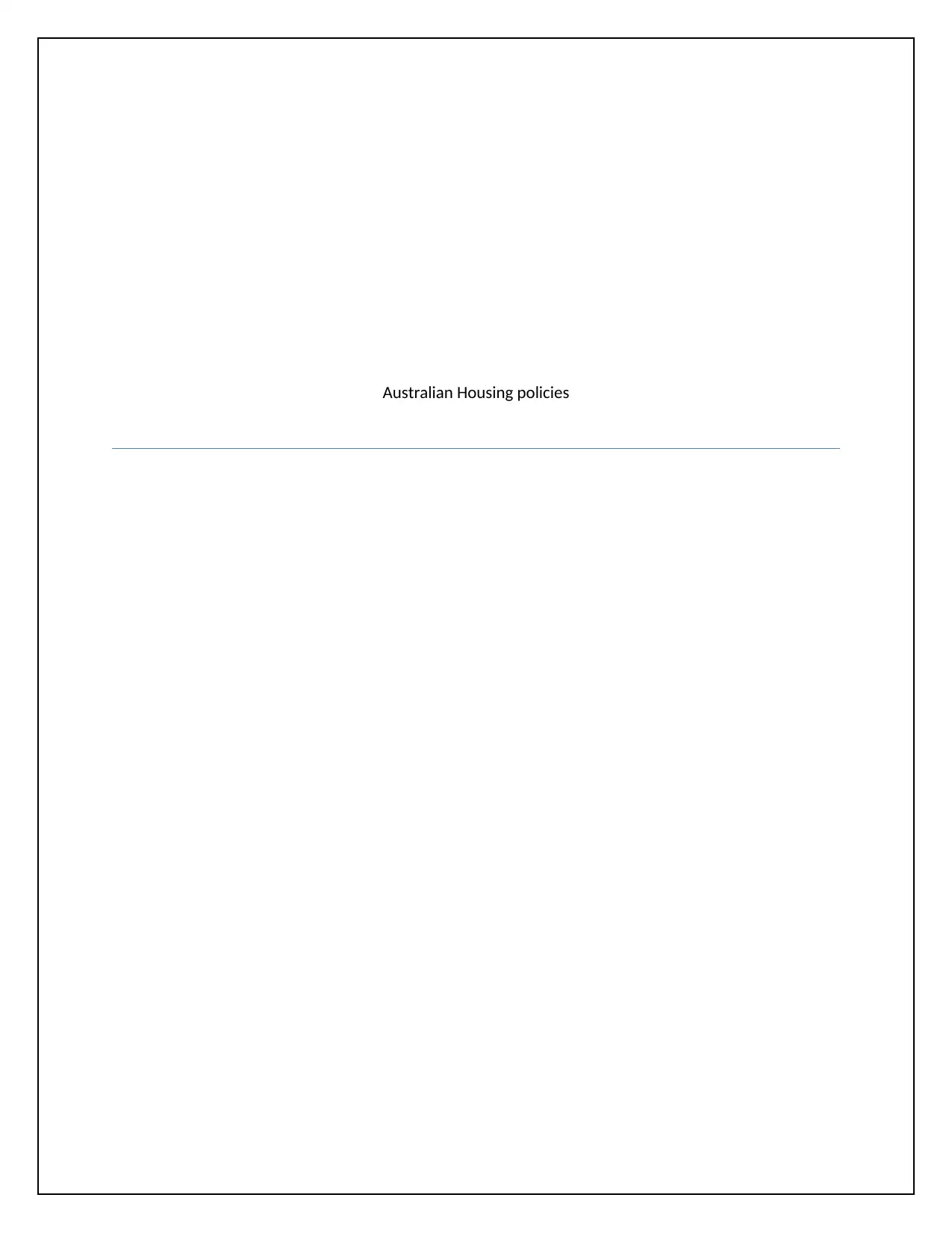
Australian Housing policies
Paraphrase This Document
Need a fresh take? Get an instant paraphrase of this document with our AI Paraphraser
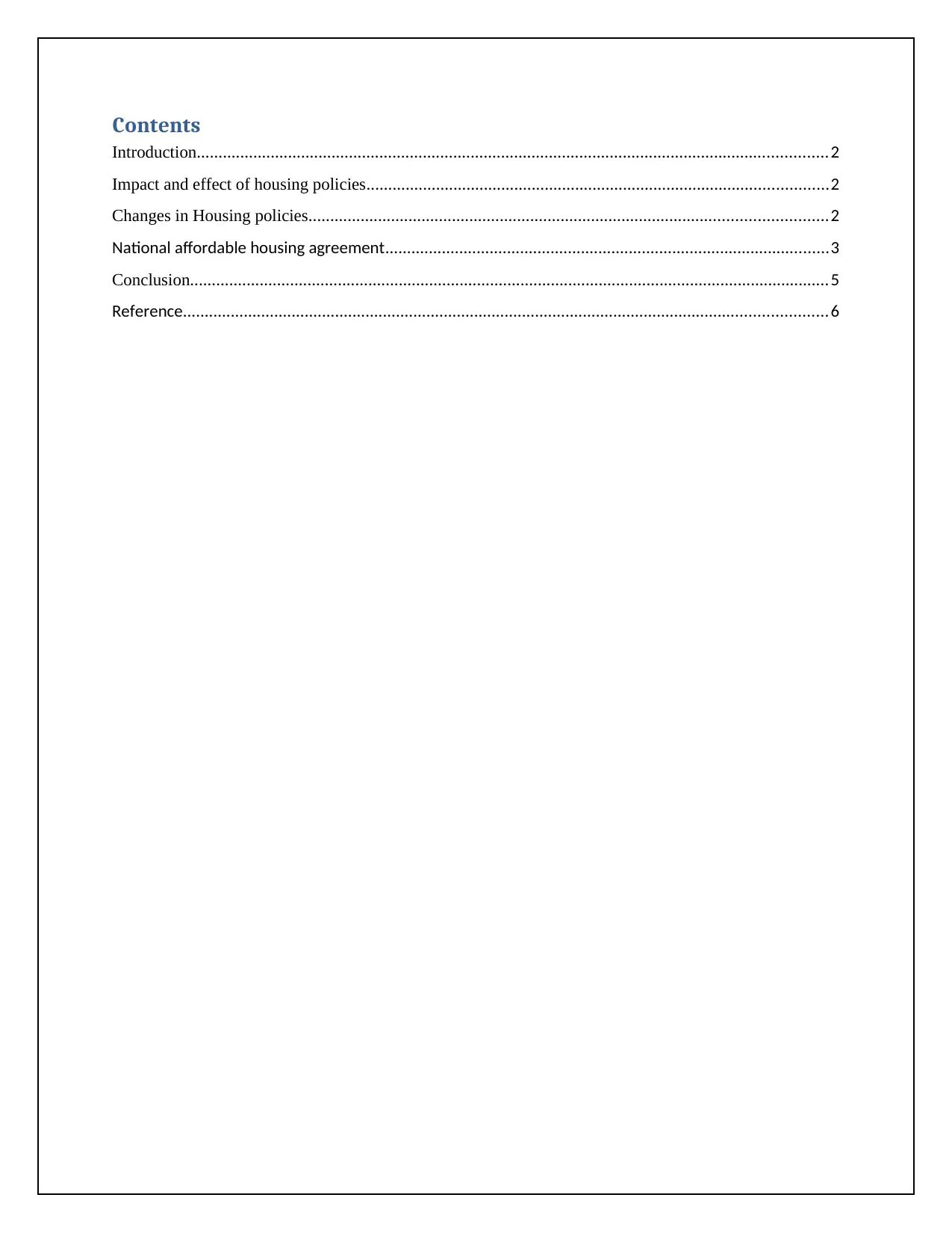
Contents
Introduction.................................................................................................................................................2
Impact and effect of housing policies..........................................................................................................2
Changes in Housing policies.......................................................................................................................2
National affordable housing agreement......................................................................................................3
Conclusion...................................................................................................................................................5
Reference....................................................................................................................................................6
Introduction.................................................................................................................................................2
Impact and effect of housing policies..........................................................................................................2
Changes in Housing policies.......................................................................................................................2
National affordable housing agreement......................................................................................................3
Conclusion...................................................................................................................................................5
Reference....................................................................................................................................................6
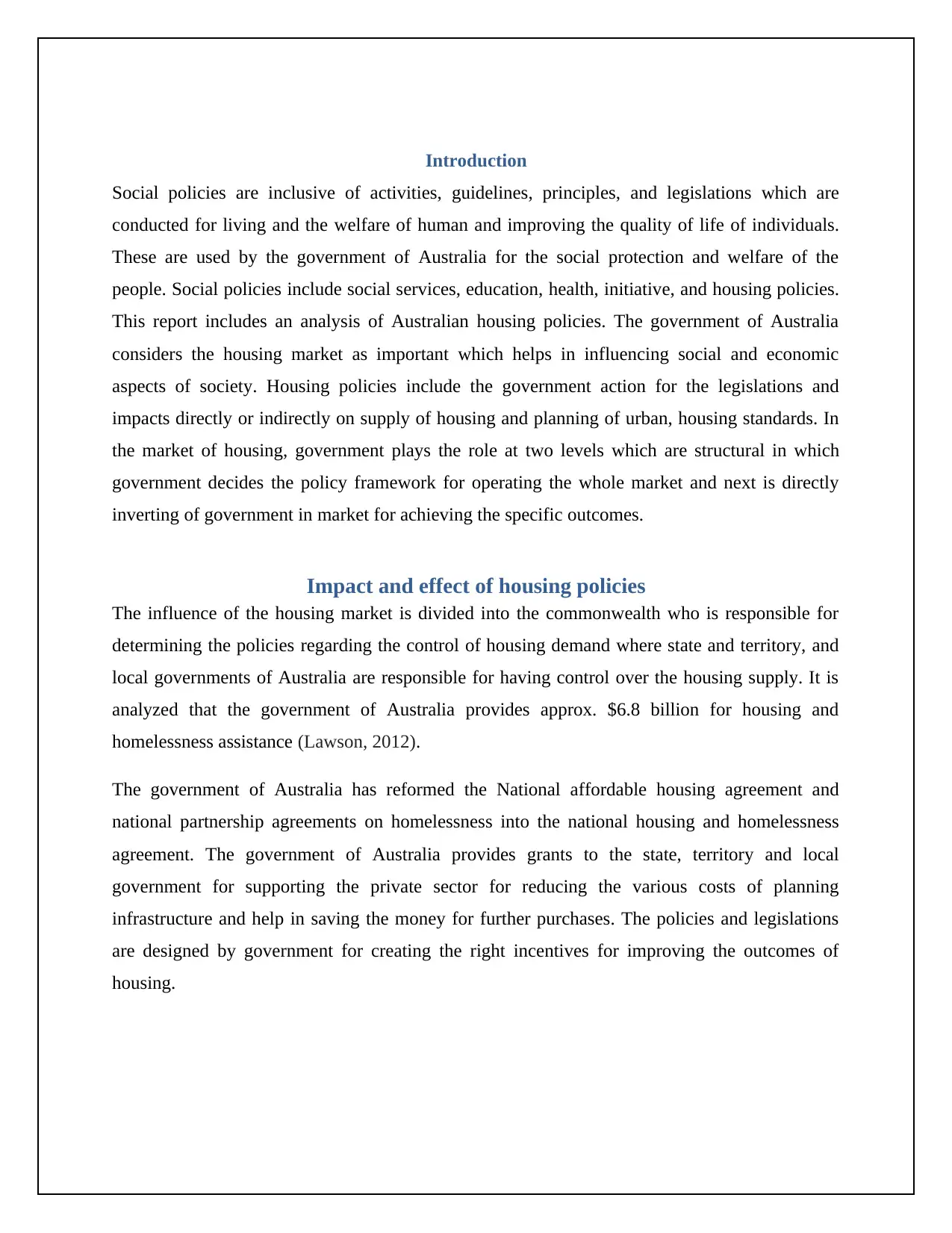
Introduction
Social policies are inclusive of activities, guidelines, principles, and legislations which are
conducted for living and the welfare of human and improving the quality of life of individuals.
These are used by the government of Australia for the social protection and welfare of the
people. Social policies include social services, education, health, initiative, and housing policies.
This report includes an analysis of Australian housing policies. The government of Australia
considers the housing market as important which helps in influencing social and economic
aspects of society. Housing policies include the government action for the legislations and
impacts directly or indirectly on supply of housing and planning of urban, housing standards. In
the market of housing, government plays the role at two levels which are structural in which
government decides the policy framework for operating the whole market and next is directly
inverting of government in market for achieving the specific outcomes.
Impact and effect of housing policies
The influence of the housing market is divided into the commonwealth who is responsible for
determining the policies regarding the control of housing demand where state and territory, and
local governments of Australia are responsible for having control over the housing supply. It is
analyzed that the government of Australia provides approx. $6.8 billion for housing and
homelessness assistance (Lawson, 2012).
The government of Australia has reformed the National affordable housing agreement and
national partnership agreements on homelessness into the national housing and homelessness
agreement. The government of Australia provides grants to the state, territory and local
government for supporting the private sector for reducing the various costs of planning
infrastructure and help in saving the money for further purchases. The policies and legislations
are designed by government for creating the right incentives for improving the outcomes of
housing.
Social policies are inclusive of activities, guidelines, principles, and legislations which are
conducted for living and the welfare of human and improving the quality of life of individuals.
These are used by the government of Australia for the social protection and welfare of the
people. Social policies include social services, education, health, initiative, and housing policies.
This report includes an analysis of Australian housing policies. The government of Australia
considers the housing market as important which helps in influencing social and economic
aspects of society. Housing policies include the government action for the legislations and
impacts directly or indirectly on supply of housing and planning of urban, housing standards. In
the market of housing, government plays the role at two levels which are structural in which
government decides the policy framework for operating the whole market and next is directly
inverting of government in market for achieving the specific outcomes.
Impact and effect of housing policies
The influence of the housing market is divided into the commonwealth who is responsible for
determining the policies regarding the control of housing demand where state and territory, and
local governments of Australia are responsible for having control over the housing supply. It is
analyzed that the government of Australia provides approx. $6.8 billion for housing and
homelessness assistance (Lawson, 2012).
The government of Australia has reformed the National affordable housing agreement and
national partnership agreements on homelessness into the national housing and homelessness
agreement. The government of Australia provides grants to the state, territory and local
government for supporting the private sector for reducing the various costs of planning
infrastructure and help in saving the money for further purchases. The policies and legislations
are designed by government for creating the right incentives for improving the outcomes of
housing.
⊘ This is a preview!⊘
Do you want full access?
Subscribe today to unlock all pages.

Trusted by 1+ million students worldwide
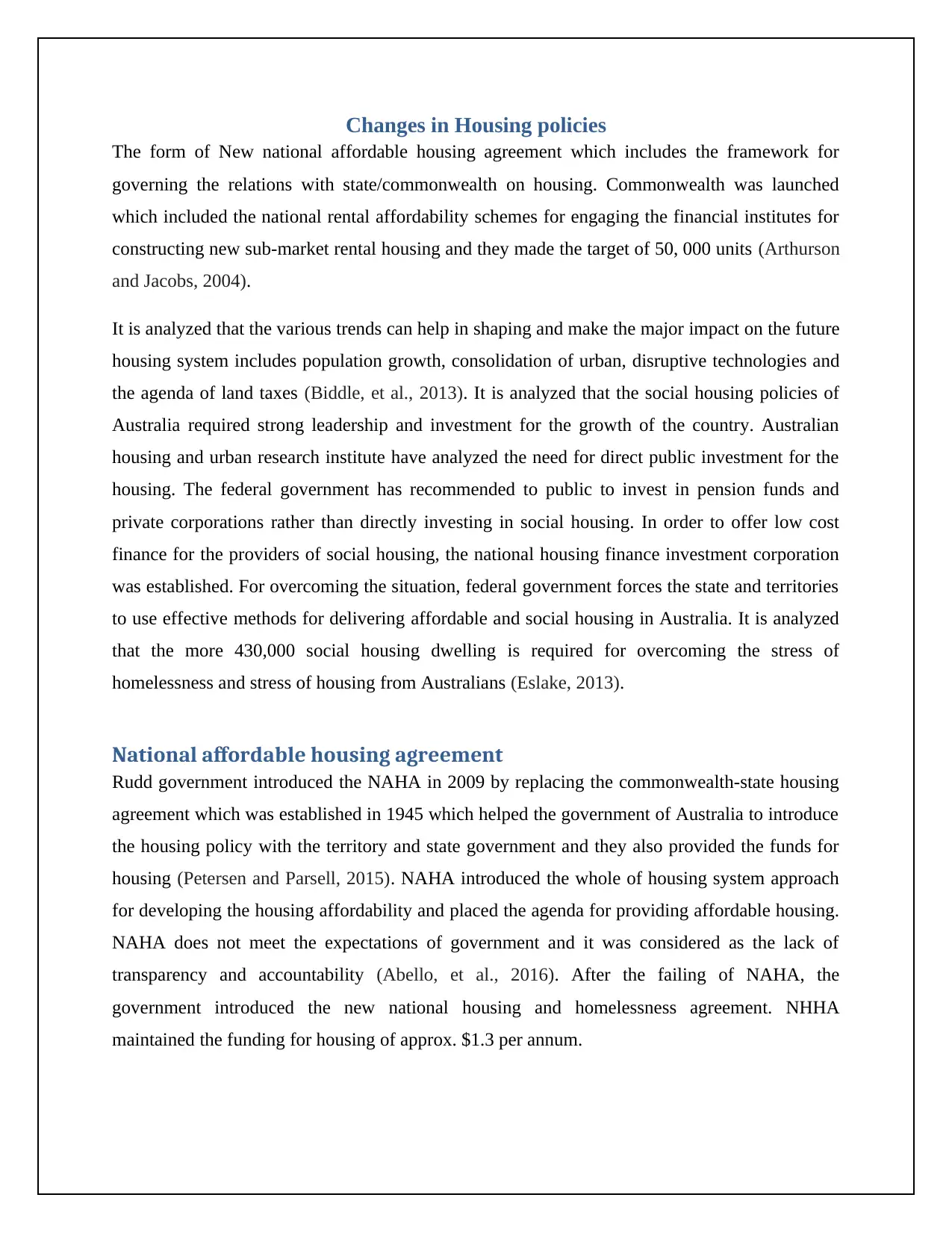
Changes in Housing policies
The form of New national affordable housing agreement which includes the framework for
governing the relations with state/commonwealth on housing. Commonwealth was launched
which included the national rental affordability schemes for engaging the financial institutes for
constructing new sub-market rental housing and they made the target of 50, 000 units (Arthurson
and Jacobs, 2004).
It is analyzed that the various trends can help in shaping and make the major impact on the future
housing system includes population growth, consolidation of urban, disruptive technologies and
the agenda of land taxes (Biddle, et al., 2013). It is analyzed that the social housing policies of
Australia required strong leadership and investment for the growth of the country. Australian
housing and urban research institute have analyzed the need for direct public investment for the
housing. The federal government has recommended to public to invest in pension funds and
private corporations rather than directly investing in social housing. In order to offer low cost
finance for the providers of social housing, the national housing finance investment corporation
was established. For overcoming the situation, federal government forces the state and territories
to use effective methods for delivering affordable and social housing in Australia. It is analyzed
that the more 430,000 social housing dwelling is required for overcoming the stress of
homelessness and stress of housing from Australians (Eslake, 2013).
National affordable housing agreement
Rudd government introduced the NAHA in 2009 by replacing the commonwealth-state housing
agreement which was established in 1945 which helped the government of Australia to introduce
the housing policy with the territory and state government and they also provided the funds for
housing (Petersen and Parsell, 2015). NAHA introduced the whole of housing system approach
for developing the housing affordability and placed the agenda for providing affordable housing.
NAHA does not meet the expectations of government and it was considered as the lack of
transparency and accountability (Abello, et al., 2016). After the failing of NAHA, the
government introduced the new national housing and homelessness agreement. NHHA
maintained the funding for housing of approx. $1.3 per annum.
The form of New national affordable housing agreement which includes the framework for
governing the relations with state/commonwealth on housing. Commonwealth was launched
which included the national rental affordability schemes for engaging the financial institutes for
constructing new sub-market rental housing and they made the target of 50, 000 units (Arthurson
and Jacobs, 2004).
It is analyzed that the various trends can help in shaping and make the major impact on the future
housing system includes population growth, consolidation of urban, disruptive technologies and
the agenda of land taxes (Biddle, et al., 2013). It is analyzed that the social housing policies of
Australia required strong leadership and investment for the growth of the country. Australian
housing and urban research institute have analyzed the need for direct public investment for the
housing. The federal government has recommended to public to invest in pension funds and
private corporations rather than directly investing in social housing. In order to offer low cost
finance for the providers of social housing, the national housing finance investment corporation
was established. For overcoming the situation, federal government forces the state and territories
to use effective methods for delivering affordable and social housing in Australia. It is analyzed
that the more 430,000 social housing dwelling is required for overcoming the stress of
homelessness and stress of housing from Australians (Eslake, 2013).
National affordable housing agreement
Rudd government introduced the NAHA in 2009 by replacing the commonwealth-state housing
agreement which was established in 1945 which helped the government of Australia to introduce
the housing policy with the territory and state government and they also provided the funds for
housing (Petersen and Parsell, 2015). NAHA introduced the whole of housing system approach
for developing the housing affordability and placed the agenda for providing affordable housing.
NAHA does not meet the expectations of government and it was considered as the lack of
transparency and accountability (Abello, et al., 2016). After the failing of NAHA, the
government introduced the new national housing and homelessness agreement. NHHA
maintained the funding for housing of approx. $1.3 per annum.
Paraphrase This Document
Need a fresh take? Get an instant paraphrase of this document with our AI Paraphraser
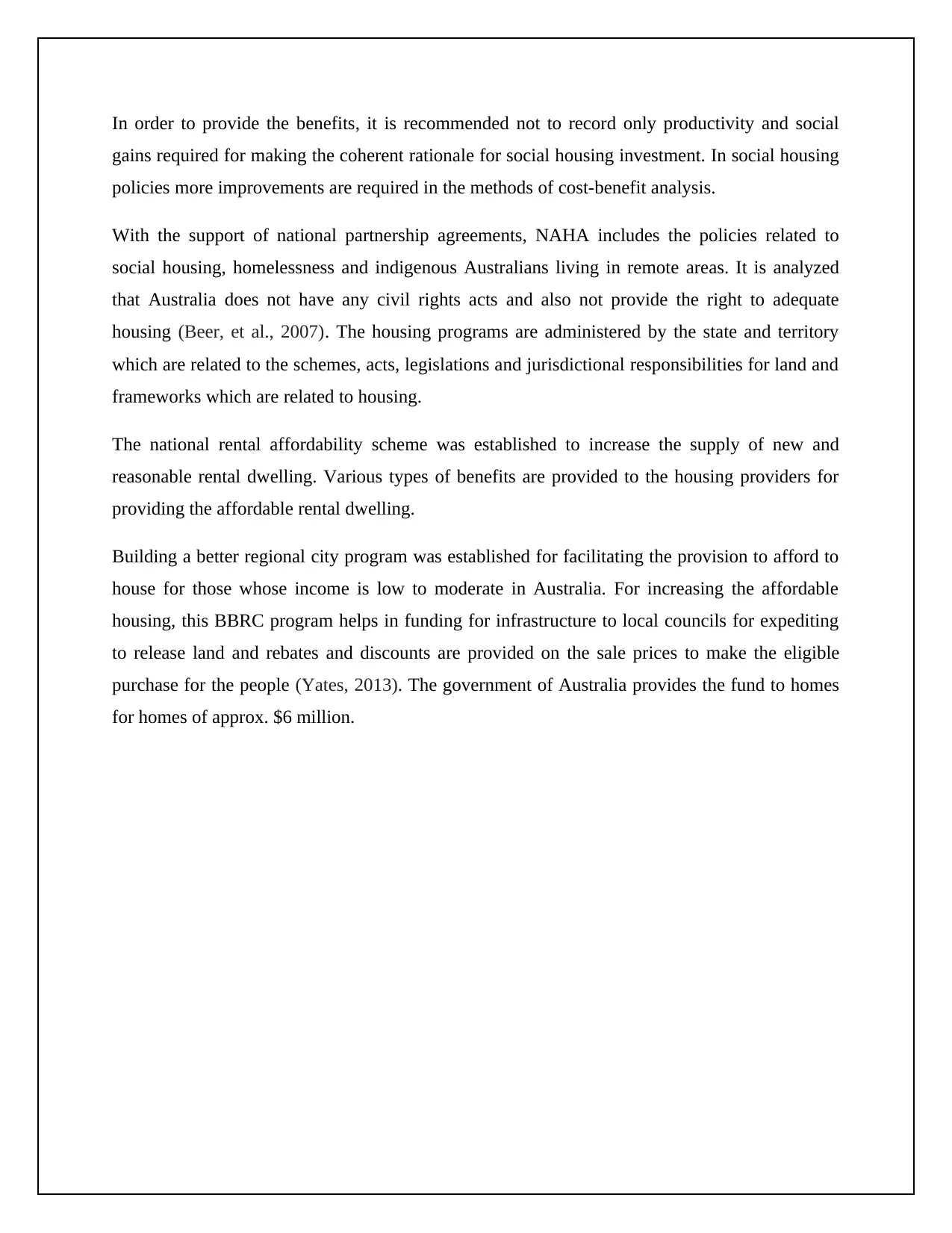
In order to provide the benefits, it is recommended not to record only productivity and social
gains required for making the coherent rationale for social housing investment. In social housing
policies more improvements are required in the methods of cost-benefit analysis.
With the support of national partnership agreements, NAHA includes the policies related to
social housing, homelessness and indigenous Australians living in remote areas. It is analyzed
that Australia does not have any civil rights acts and also not provide the right to adequate
housing (Beer, et al., 2007). The housing programs are administered by the state and territory
which are related to the schemes, acts, legislations and jurisdictional responsibilities for land and
frameworks which are related to housing.
The national rental affordability scheme was established to increase the supply of new and
reasonable rental dwelling. Various types of benefits are provided to the housing providers for
providing the affordable rental dwelling.
Building a better regional city program was established for facilitating the provision to afford to
house for those whose income is low to moderate in Australia. For increasing the affordable
housing, this BBRC program helps in funding for infrastructure to local councils for expediting
to release land and rebates and discounts are provided on the sale prices to make the eligible
purchase for the people (Yates, 2013). The government of Australia provides the fund to homes
for homes of approx. $6 million.
gains required for making the coherent rationale for social housing investment. In social housing
policies more improvements are required in the methods of cost-benefit analysis.
With the support of national partnership agreements, NAHA includes the policies related to
social housing, homelessness and indigenous Australians living in remote areas. It is analyzed
that Australia does not have any civil rights acts and also not provide the right to adequate
housing (Beer, et al., 2007). The housing programs are administered by the state and territory
which are related to the schemes, acts, legislations and jurisdictional responsibilities for land and
frameworks which are related to housing.
The national rental affordability scheme was established to increase the supply of new and
reasonable rental dwelling. Various types of benefits are provided to the housing providers for
providing the affordable rental dwelling.
Building a better regional city program was established for facilitating the provision to afford to
house for those whose income is low to moderate in Australia. For increasing the affordable
housing, this BBRC program helps in funding for infrastructure to local councils for expediting
to release land and rebates and discounts are provided on the sale prices to make the eligible
purchase for the people (Yates, 2013). The government of Australia provides the fund to homes
for homes of approx. $6 million.
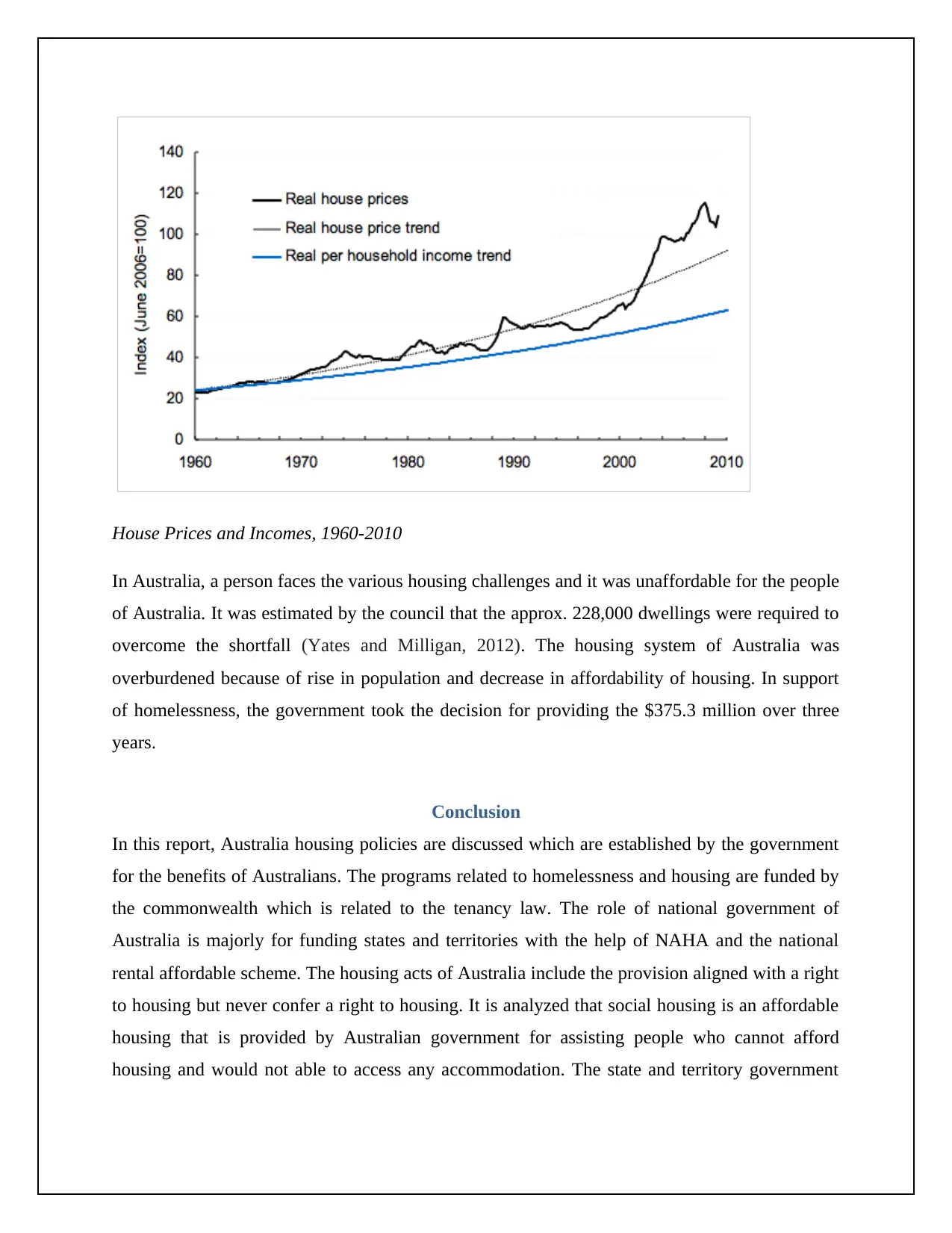
House Prices and Incomes, 1960-2010
In Australia, a person faces the various housing challenges and it was unaffordable for the people
of Australia. It was estimated by the council that the approx. 228,000 dwellings were required to
overcome the shortfall (Yates and Milligan, 2012). The housing system of Australia was
overburdened because of rise in population and decrease in affordability of housing. In support
of homelessness, the government took the decision for providing the $375.3 million over three
years.
Conclusion
In this report, Australia housing policies are discussed which are established by the government
for the benefits of Australians. The programs related to homelessness and housing are funded by
the commonwealth which is related to the tenancy law. The role of national government of
Australia is majorly for funding states and territories with the help of NAHA and the national
rental affordable scheme. The housing acts of Australia include the provision aligned with a right
to housing but never confer a right to housing. It is analyzed that social housing is an affordable
housing that is provided by Australian government for assisting people who cannot afford
housing and would not able to access any accommodation. The state and territory government
In Australia, a person faces the various housing challenges and it was unaffordable for the people
of Australia. It was estimated by the council that the approx. 228,000 dwellings were required to
overcome the shortfall (Yates and Milligan, 2012). The housing system of Australia was
overburdened because of rise in population and decrease in affordability of housing. In support
of homelessness, the government took the decision for providing the $375.3 million over three
years.
Conclusion
In this report, Australia housing policies are discussed which are established by the government
for the benefits of Australians. The programs related to homelessness and housing are funded by
the commonwealth which is related to the tenancy law. The role of national government of
Australia is majorly for funding states and territories with the help of NAHA and the national
rental affordable scheme. The housing acts of Australia include the provision aligned with a right
to housing but never confer a right to housing. It is analyzed that social housing is an affordable
housing that is provided by Australian government for assisting people who cannot afford
housing and would not able to access any accommodation. The state and territory government
⊘ This is a preview!⊘
Do you want full access?
Subscribe today to unlock all pages.

Trusted by 1+ million students worldwide
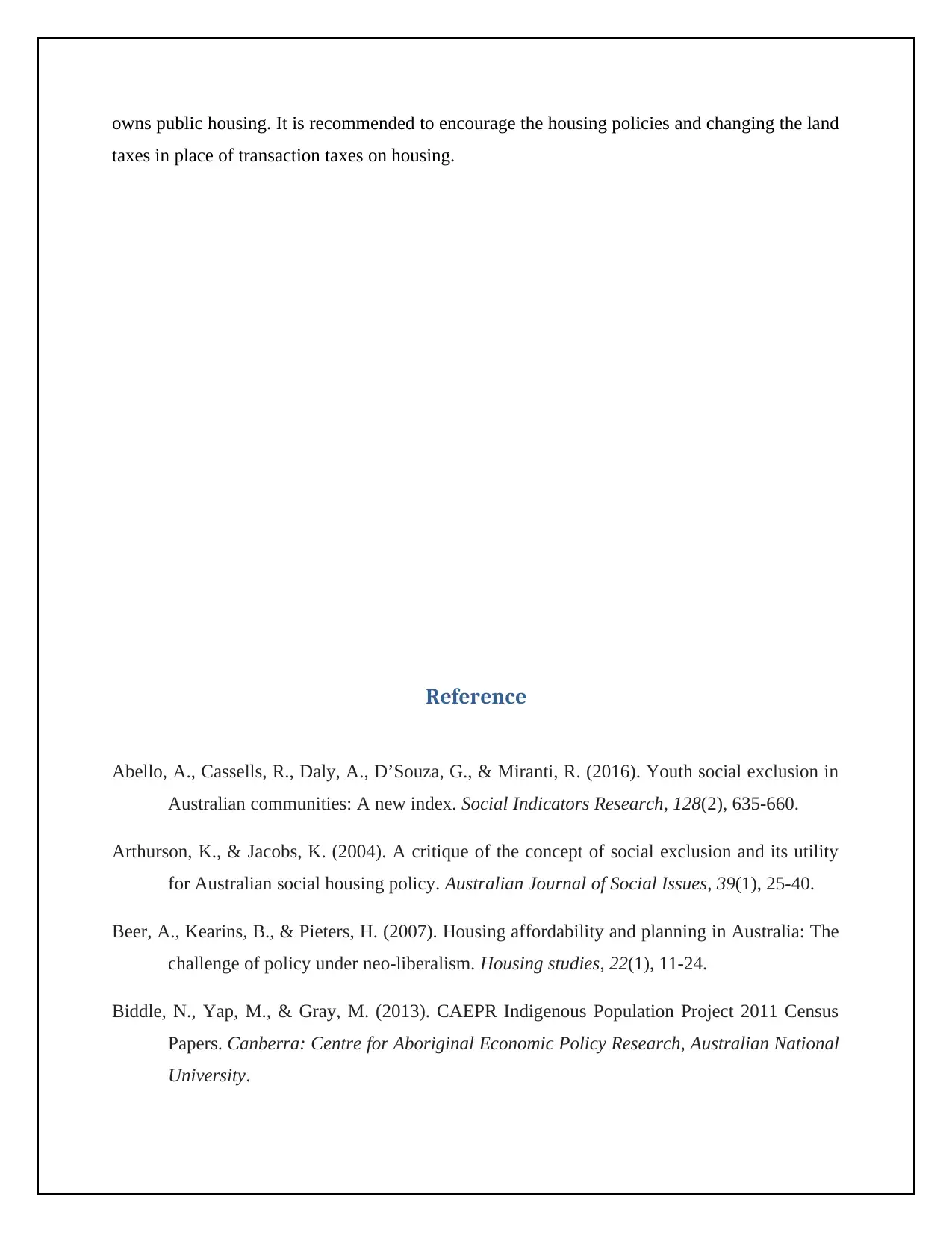
owns public housing. It is recommended to encourage the housing policies and changing the land
taxes in place of transaction taxes on housing.
Reference
Abello, A., Cassells, R., Daly, A., D’Souza, G., & Miranti, R. (2016). Youth social exclusion in
Australian communities: A new index. Social Indicators Research, 128(2), 635-660.
Arthurson, K., & Jacobs, K. (2004). A critique of the concept of social exclusion and its utility
for Australian social housing policy. Australian Journal of Social Issues, 39(1), 25-40.
Beer, A., Kearins, B., & Pieters, H. (2007). Housing affordability and planning in Australia: The
challenge of policy under neo-liberalism. Housing studies, 22(1), 11-24.
Biddle, N., Yap, M., & Gray, M. (2013). CAEPR Indigenous Population Project 2011 Census
Papers. Canberra: Centre for Aboriginal Economic Policy Research, Australian National
University.
taxes in place of transaction taxes on housing.
Reference
Abello, A., Cassells, R., Daly, A., D’Souza, G., & Miranti, R. (2016). Youth social exclusion in
Australian communities: A new index. Social Indicators Research, 128(2), 635-660.
Arthurson, K., & Jacobs, K. (2004). A critique of the concept of social exclusion and its utility
for Australian social housing policy. Australian Journal of Social Issues, 39(1), 25-40.
Beer, A., Kearins, B., & Pieters, H. (2007). Housing affordability and planning in Australia: The
challenge of policy under neo-liberalism. Housing studies, 22(1), 11-24.
Biddle, N., Yap, M., & Gray, M. (2013). CAEPR Indigenous Population Project 2011 Census
Papers. Canberra: Centre for Aboriginal Economic Policy Research, Australian National
University.
Paraphrase This Document
Need a fresh take? Get an instant paraphrase of this document with our AI Paraphraser
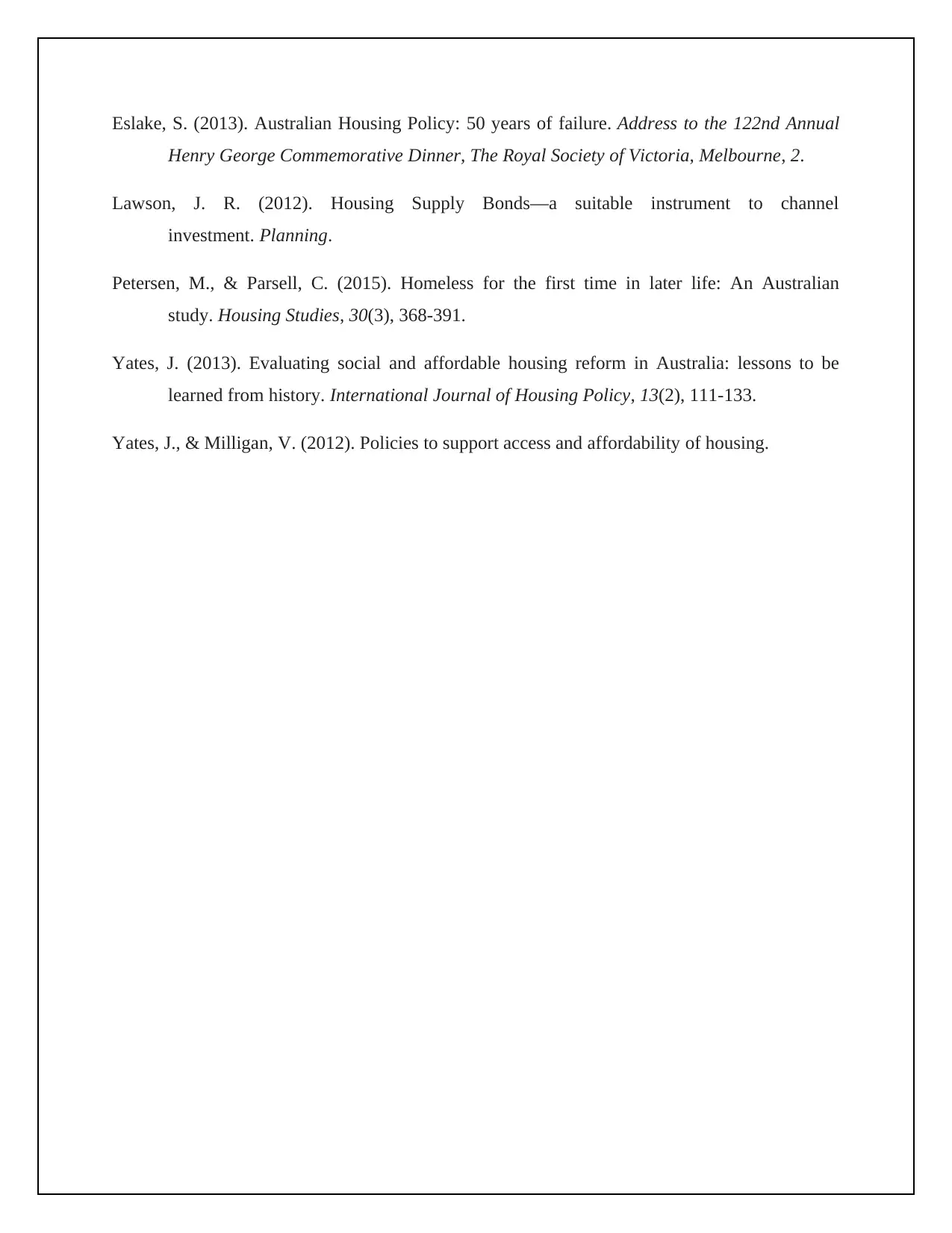
Eslake, S. (2013). Australian Housing Policy: 50 years of failure. Address to the 122nd Annual
Henry George Commemorative Dinner, The Royal Society of Victoria, Melbourne, 2.
Lawson, J. R. (2012). Housing Supply Bonds—a suitable instrument to channel
investment. Planning.
Petersen, M., & Parsell, C. (2015). Homeless for the first time in later life: An Australian
study. Housing Studies, 30(3), 368-391.
Yates, J. (2013). Evaluating social and affordable housing reform in Australia: lessons to be
learned from history. International Journal of Housing Policy, 13(2), 111-133.
Yates, J., & Milligan, V. (2012). Policies to support access and affordability of housing.
Henry George Commemorative Dinner, The Royal Society of Victoria, Melbourne, 2.
Lawson, J. R. (2012). Housing Supply Bonds—a suitable instrument to channel
investment. Planning.
Petersen, M., & Parsell, C. (2015). Homeless for the first time in later life: An Australian
study. Housing Studies, 30(3), 368-391.
Yates, J. (2013). Evaluating social and affordable housing reform in Australia: lessons to be
learned from history. International Journal of Housing Policy, 13(2), 111-133.
Yates, J., & Milligan, V. (2012). Policies to support access and affordability of housing.
1 out of 8
Related Documents
Your All-in-One AI-Powered Toolkit for Academic Success.
+13062052269
info@desklib.com
Available 24*7 on WhatsApp / Email
![[object Object]](/_next/static/media/star-bottom.7253800d.svg)
Unlock your academic potential
Copyright © 2020–2025 A2Z Services. All Rights Reserved. Developed and managed by ZUCOL.





